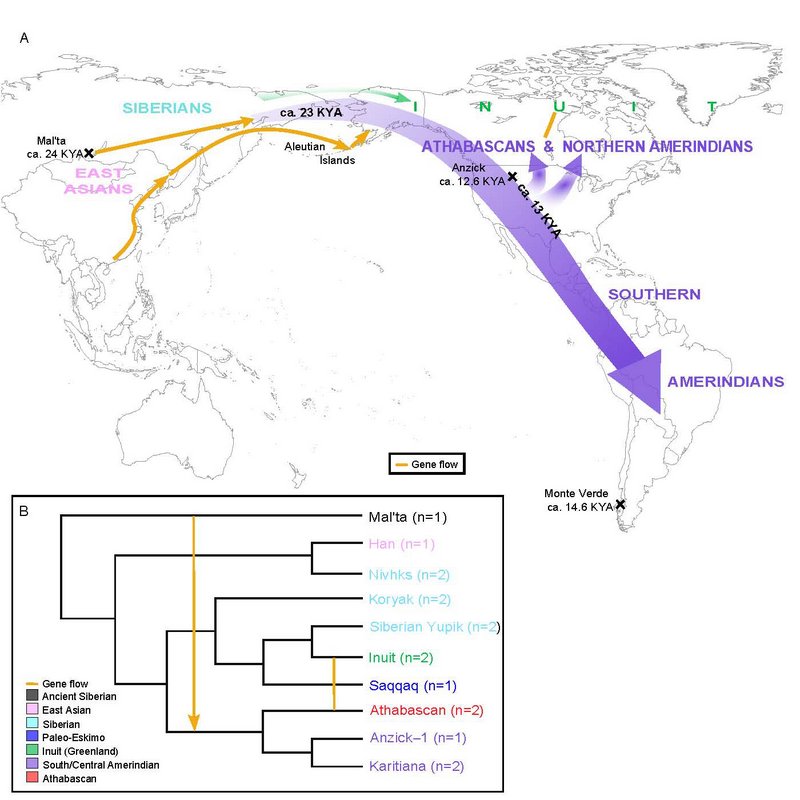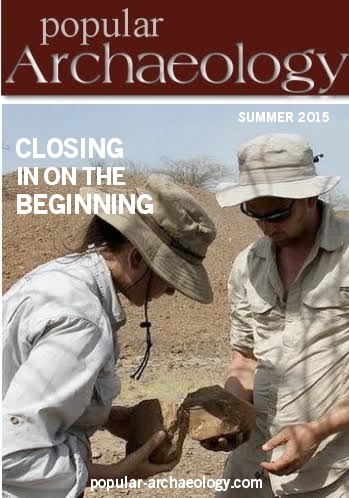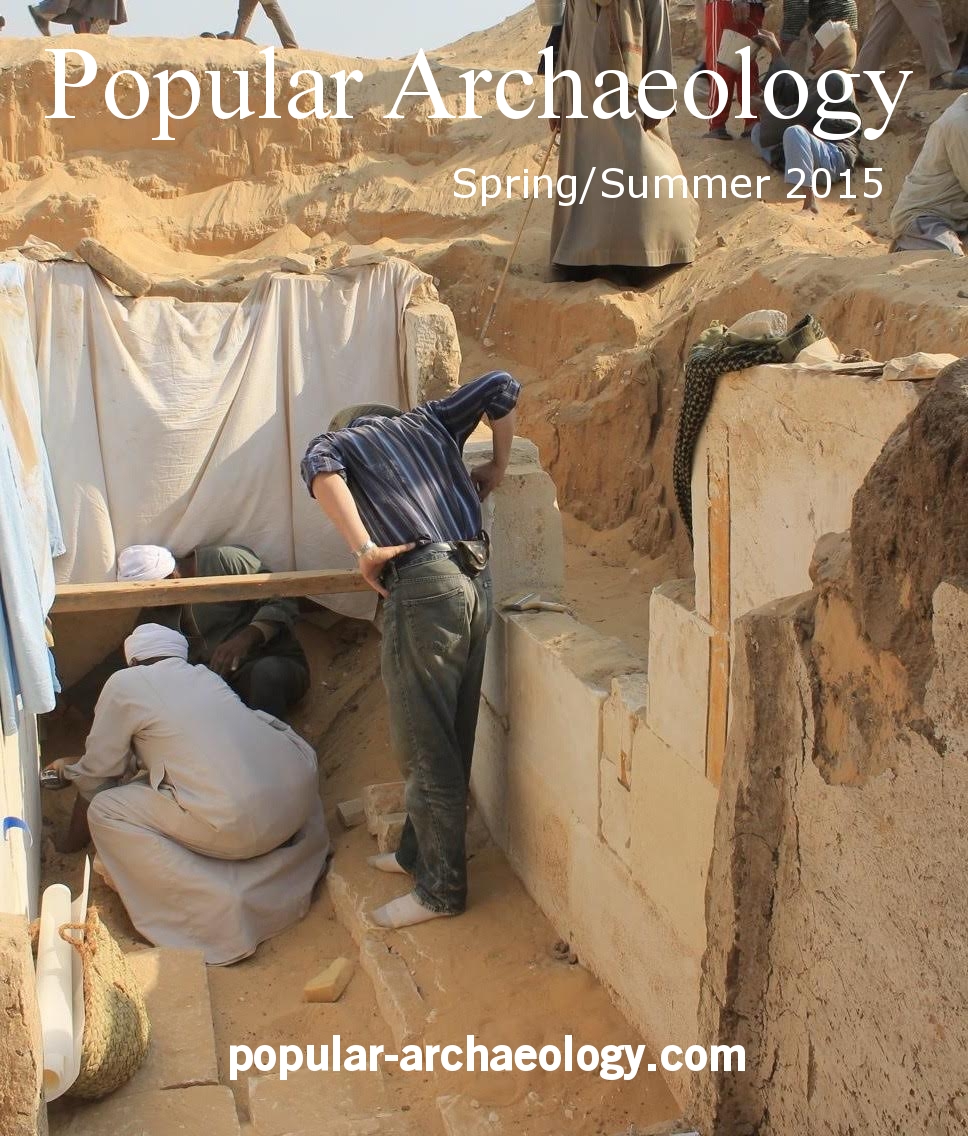
In what could turn out to be a landmark study, researchers have pieced together a new picture of how and when the ancestors of present-day Native Americans entered the Americas.
Using genetic data from the remains of ancient individuals as well as that of modern individuals, Maanasa Raghaven of the University of Copenhagen and colleagues from an international array of multiple institutions sequenced and compared the genomes of ancient and modern individuals from the Americas, Siberia, and Oceania, including the application of a range of analyses that also leveraged previously published genomic datasets from Europe and Africa.
The results of their analysis suggested that the earliest, Late Pleistocene ancestors of Native Americans entered the Americas in a single wave from a single source population—not in multiple waves from different, geographically disparate population sources, as some scholars have suggested. Moreover, they estimate that this group migrated from Siberia to the Americas no earlier than 23,000 years ago, during the harsh and frigid Last Glacial Maximum – and after no more than 8,000 years of isolation from the ancestral Siberian population. The study results also suggest that present-day genetic differences were due to genetic changes or events occuring after the initial migration.
“Our results show the Siberian Yupik and Koryak are the closest Eurasian populations to the Americas, with the Yupik likely representing back-migration of the Inuit into Siberia,” stated the authors in the study report. Using demographic models, they also suggested that “the split of Native Americans (including Amerindians and Athabascans) from the Koryak dates to ca. 20 kya.”*
Though it is generally accepted that ancestors of modern-day Native Americans descended from Siberians who crossed the Bering Land Bridge, the exact timing and pattern of entry has been hotly debated, revolving around the issues of when ancestral Native Americans left Siberia, whether they came to the Americas in one wave or multiple (with multiple times explaining the current genetic diversity), and how long they spent isolated in the Bering Strait region before arriving, with one model (the Beringian Incubation Model) suggesting as much as 15,000 years.
Perhaps most significantly, their findings lend further support to a pre-Clovis presence of humans in the Americas, a subject of great debate over the years among scholars. Mounting archaeological evidence over the past few decades, however, have provided increasing support to those challenging the Clovis First theory, which advances the notion that the earliest peoples who entered the Americas were associated with a distinct stone tool industry or culture with an earliest date of approximately 12.6 kya.
But the research also shows a major twist in the genetic journey of the earliest Americans—specifically, that the group split off into two branches around 13,000 years ago, coinciding with glacier melt and the opening of routes into North America’s interior, combined with additional admixture leading to the diversity of Native American populations we see today:
“The data presented here are consistent with a single initial migration of all Native Americans and with later gene flow from sources related to East Asians and, more distantly, Australo-Melanesians. From that single migration, there was a diversification of ancestral Native Americans leading to the formation of ‘northern’[ancestors of the Athabascans and northern Amerindian groups] and ‘southern’[Amerindians from southern North America and Central and South America] branches, which appears to have taken place ca. 13 KYA within the Americas.”*
________________________________________
 Origins and population history of Native Americans, based on the research by Raghavan et al. [Credit: Raghavan et al., Science (2015)]
Origins and population history of Native Americans, based on the research by Raghavan et al. [Credit: Raghavan et al., Science (2015)]
________________________________________
The research paper is published with free access in the 23 July issue of Science Express, a publication of the American Association for the Advancement of Science (AAAS).
________________________________________
* Maanasa Raghaven, et al., Genomic evidence for the Pleistocene and recent population history of Native Americans, Science Express, 23 July 2015
Some content for this article was adapted and edited from the related AAAS press release.
_________________________________________________
 Read more in-depth articles about archaeology with a premium subscription to Popular Archaeology Magazine.
Read more in-depth articles about archaeology with a premium subscription to Popular Archaeology Magazine.
In addition, the latest Popular Archaeology ebook is now available.
______________________________________________
Travel and learn with Far Horizons.
____________________________________________
 This richly illustrated ebook version of a recent Popular Archaeology issue includes the following stories: The discovery of the tomb of a previously unknown pharaoh that is shedding light on a lost ancient Egyptian dynasty; how genetics is revolutionizing what we know about human evolution and our prehistoric past; one scholar’s controversial ‘New Chronology’ and how it supports the historicity of the biblical Exodus; how archaeologists are unearthing new history in Williamsburg, Virginia, a seat of British colonial power in 18th century America; the discovery of the remains of a major Roman legionary base in Israel; the unearthing of an ancient Judean fortified settlement in the borderlands between the biblical kingdoms of ancient Judah and the Philistines; and how archaeologists are uncovering evidence of what may have been an important administrative center of Judah during the 8th century BCE. Now available from Amazon.com!
This richly illustrated ebook version of a recent Popular Archaeology issue includes the following stories: The discovery of the tomb of a previously unknown pharaoh that is shedding light on a lost ancient Egyptian dynasty; how genetics is revolutionizing what we know about human evolution and our prehistoric past; one scholar’s controversial ‘New Chronology’ and how it supports the historicity of the biblical Exodus; how archaeologists are unearthing new history in Williamsburg, Virginia, a seat of British colonial power in 18th century America; the discovery of the remains of a major Roman legionary base in Israel; the unearthing of an ancient Judean fortified settlement in the borderlands between the biblical kingdoms of ancient Judah and the Philistines; and how archaeologists are uncovering evidence of what may have been an important administrative center of Judah during the 8th century BCE. Now available from Amazon.com!
____________________________________________







